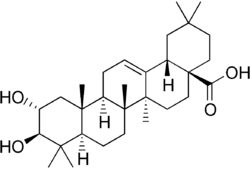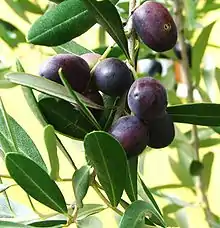Maslinsäure
Maslinsäure ist ein pentazyklisches Triterpen, das aus fünf Cyclohexanringen aufgebaut ist. Maslinsäure ist ein natürlicher Bestandteil des Olivenöls.
| Strukturformel | |||||||||||||||||||
|---|---|---|---|---|---|---|---|---|---|---|---|---|---|---|---|---|---|---|---|
 | |||||||||||||||||||
| Allgemeines | |||||||||||||||||||
| Name | Maslinsäure | ||||||||||||||||||
| Andere Namen | |||||||||||||||||||
| Summenformel | C30H48O4 | ||||||||||||||||||
| Kurzbeschreibung |
farblose Kristalle[2] | ||||||||||||||||||
| Externe Identifikatoren/Datenbanken | |||||||||||||||||||
| |||||||||||||||||||
| Eigenschaften | |||||||||||||||||||
| Molare Masse | 472,70 g·mol−1 | ||||||||||||||||||
| Aggregatzustand |
fest | ||||||||||||||||||
| Löslichkeit | |||||||||||||||||||
| Sicherheitshinweise | |||||||||||||||||||
| |||||||||||||||||||
| Soweit möglich und gebräuchlich, werden SI-Einheiten verwendet. Wenn nicht anders vermerkt, gelten die angegebenen Daten bei Standardbedingungen. | |||||||||||||||||||
Vorkommen

Maslinsäure findet sich als wachsartige Schutzschicht auf den Blättern und den Früchten des Olivenbaums.[4] In Oliven liegt der Gehalt an Maslinsäure zwischen etwa 700 und 1000 mg pro kg. Mit zunehmender Reifung nimmt der Gehalt ab.[5] Pro Kilogramm nativem Olivenöl können bis zu 250 mg Maslinsäure enthalten sein. In raffiniertem Öl ist der Gehalt an Maslinsäure erheblich niedriger. Die Press- und Zentrifugenrückstände von der Olivenölherstellung sind eine wichtige Quelle zur Gewinnung von Maslinsäure und anderen verwandten pentacyclischen Triterpenen, wie beispielsweise Oleanolsäure. Aus diesen Rückständen lassen sich die Triterpene durch Extraktion mit Lösungsmitteln gewinnen.[6][7]
Auch in der Japanischen Nelkenwurz (Geum japonicum)[8], der Königinblume (Lagerstroemia speciosa)[9] der Kleinen Braunelle (Prunella vulgaris),[10] dem Asiatischen Blüten-Hartriegel (Cornus kousa),[11] der Sibirischen Ulme (Ulmus pumila),[12] im Chinagras (Boehmeria nivea)[13] und einer Reihe anderer Pflanzen konnte Maslinsäure nachgewiesen und isoliert werden.
Eigenschaften und pharmakologisches Potenzial
Maslinsäure ist zytotoxisch. Sie ist zwar nicht in der Lage freie Radikale abzufangen, bewirkt aber einen Schutz der DNA gegen Oxidation.[14] In In-vitro-Versuchen konnte eine antiproliferative und apoptoseauslösende Wirkung der Maslinsäure nachgewiesen werden.[4] Maslinsäure aktiviert Caspase-3,[15] ein für die Apoptose wichtiges Enzym. Die Verbindung scheint darüber hinaus die Gefäßneubildung (Angiogenese)[16] sowie das Enzym Cyclooxygenase-2 (COX-2) zu inhibieren.[17] Eine anti-diabetische Wirkung konnte in Modellorganismen nachgewiesen werden.[18]
An verschiedenen Krebszelllinien – insbesondere an Dickdarmkrebszellen – wurde eine anti-karzinogene Wirkung nachgewiesen. Es wird vermutet, dass das aus epidemiologischen Daten her bekannte, vergleichsweise niedrige Dickdarmrisiko der mediterranen Bevölkerung mit dem vergleichsweise hohen Verzehr an Olivenöl und Oliven zusammenhängt und eine der Ursachen der Olivenbestandteil Maslinsäure ist. Pro Person und Tag liegt dort die Aufnahme an Maslinsäure bei etwa 62 mg.[6] Darüber hinaus konnten kardioprotektive Eigenschaften der Maslinsäure nachgewiesen werden.[19]
Gegenüber parasitären Krankheitserregern, wie beispielsweise Plasmodien (Plasmodium falciparum[20][21] oder Toxoplasma gondii[22]) oder Protozoen wie Eimeria tenella,[23] zeigt Maslinsäure eine anti-parasitäre Wirkung.
Weiterführende Literatur
- X. Wen, H. Sun, J. Liu, K. Cheng, P. Zhang, L. Zhang, J. Hao, L. Zhang, P. Ni, u. a.: Naturally occurring pentacyclic triterpenes as inhibitors of glycogen phosphorylase: synthesis, structure-activity relationships, and X-ray crystallographic studies. In: Journal of Medicinal Chemistry Band 51, Nummer 12, Juni 2008, S. 3540–3554, doi:10.1021/jm8000949. PMID 18517260.
- C. Li, Z. Yang, Z. Li, Y. Ma, L. Zhang, C. Zheng, W. Qiu, X. Wu, u. a.: Maslinic acid suppresses osteoclastogenesis and prevents ovariectomy-induced bone loss by regulating RANKL-mediated NF-κB and MAPK signaling pathways. In: Journal of Bone and Mineral Research Band 26, Nummer 3, März 2011, S. 644–656, doi:10.1002/jbmr.242. PMID 20814972.
- C. Li, Z. Yang, C. Zhai, W. Qiu, D. Li, Z. Yi, L. Wang, u. a.: Maslinic acid potentiates the anti-tumor activity of tumor necrosis factor alpha by inhibiting NF-kappaB signaling pathway. In: Molecular Cancer Band 9, 2010, S. 73, doi:10.1186/1476-4598-9-73. PMID 20367887. PMC 2907730 (freier Volltext).
- L. Y. Mooi, N. A. Wahab, N. H. Lajis, A. M. Ali: Chemopreventive properties of phytosterols and maslinic acid extracted from Coleus tuberosus in inhibiting the expression of EBV early-antigen in Raji cells. In: Chemistry & biodiversity Band 7, Nummer 5, Mai 2010, S. 1267–1275, doi:10.1002/cbdv.200900193. PMID 20491082.
- W. W. Qiu, Q. Shen, F. Yang, B. Wang, H. Zou, J. Y. Li, J. Li, J. Tang: Synthesis and biological evaluation of heterocyclic ring-substituted maslinic acid derivatives as novel inhibitors of protein tyrosine phosphatase 1B. In: Bioorganic & medicinal chemistry letters Band 19, Nummer 23, Dezember 2009, S. 6618–6622, doi:10.1016/j.bmcl.2009.10.017. PMID 19846303.
- T. Guan, Y. Li, H. Sun, X. Tang, Y. Qian: Effects of maslinic acid, a natural triterpene, on glycogen metabolism in cultured cortical astrocytes. In: Planta Medica Band 75, Nummer 10, August 2009, S. 1141–1143, doi:10.1055/s-0029-1185481. PMID 19291614.
Einzelnachweise
- Hagers Handbuch der Pharmazeutischen Praxis. Drogen E–O, 5. Auflage, Springer, 1993, ISBN 978-3-642-63427-7, S. 938.
- Datenblatt Maslinsäure bei Sigma-Aldrich, abgerufen am 2. September 2016 (PDF).
- Maslinic Acid. Cayman Chemicals, vom 8. Dezember 2009.
- F. J. Reyes-Zurita, G. Pachón-Peña, D. Lizárraga, E. E. Rufino-Palomares, M. Cascante, J. A. Lupiáñez: The natural triterpene maslinic acid induces apoptosis in HT29 colon cancer cells by a JNK-p53-dependent mechanism. In: BMC Cancer Band 11, 2011, S. 154, doi:10.1186/1471-2407-11-154. PMID 21524306. PMC 3103477 (freier Volltext).
- A. Guinda, M. Rada, T. Delgado, P. Gutiérrez-Adánez, J. M. Castellano: Pentacyclic triterpenoids from olive fruit and leaf. In: Journal of Agricultural and Food Chemistry Band 58, Nummer 17, September 2010, S. 9685–9691, doi:10.1021/jf102039t. PMID 20712364.
- H. Schmandke: Triterpenoide in Oliven. (PDF; 283 kB) In: Ernährungs Umschau 2, 2009, S. 92–95.
- A. Parra, P. E. Lopez, A. Garcia-Granados: Bioactive compounds with added value prepared from terpenes contained in solid wastes from the olive oil industry. In: Chemistry & biodiversity Band 7, Nummer 2, Februar 2010, S. 421–439, doi:10.1002/cbdv.200900023. PMID 20151391.
- H. X. Xu, F. Q. Zeng, M. Wan, K. Y. Sim: Anti-HIV triterpene acids from Geum japonicum. In: Journal of Natural Products Band 59, Nummer 7, Juli 1996, S. 643–645, doi:10.1021/np960165e. PMID 8759159.
- W. Hou, Y. Li, Q. Zhang, X. Wei, A. Peng, L. Chen, Y. Wei: Triterpene acids isolated from Lagerstroemia speciosa leaves as alpha-glucosidase inhibitors. In: Phytotherapy Research : PTR Band 23, Nummer 5, Mai 2009, S. 614–618, doi:10.1002/ptr.2661. PMID 19107840.
- I. K. Lee, d. o. Kim, S. Y. Lee, K. R. Kim, S. U. Choi, J. K. Hong, J. H. Lee, Y. H. Park, K. R. Lee: Triterpenoic acids of Prunella vulgaris var. lilacina and their cytotoxic activities in vitro. In: Archives of Pharmacal Research Band 31, Nummer 12, Dezember 2008, S. 1578–1583, doi:10.1007/s12272-001-2154-6. PMID 19099227.
- N. Sultana, N. H. Lee: Antielastase and free radical scavenging activities of compounds from the stems of Cornus kousa. In: Phytotherapy research : PTR Band 21, Nummer 12, Dezember 2007, S. 1171–1176, doi:10.1002/ptr.2230. PMID 17661332.
- D. Wang, M. Xia, Z. Cui: New triterpenoids isolated from the root bark of Ulmus pumila L. In: Chemical & pharmaceutical bulletin Band 54, Nummer 6, Juni 2006, S. 775–778, PMID 16755042.
- Q. Xu, G. Chen, J. Fan, M. Zhang, X. Li, S. Yang, X. Li: [Chemical constituents of roots of Boehmeria nivea]. In: Zhongguo Zhong yao za zhi Band 34, Nummer 20, Oktober 2009, S. 2610–2612, PMID 20069903.
- Y. Allouche, F. Warleta, M. Campos, C. Sánchez-Quesada, M. Uceda, G. Beltrán, J. J. Gaforio: Antioxidant, antiproliferative, and pro-apoptotic capacities of pentacyclic triterpenes found in the skin of olives on MCF-7 human breast cancer cells and their effects on DNA damage. In: Journal of agricultural and food chemistry Band 59, Nummer 1, Januar 2011, S. 121–130, doi:10.1021/jf102319y. PMID 21142067.
- M. E. Juan, J. M. Planas, V. Ruiz-Gutierrez, H. Daniel, U. Wenzel: Antiproliferative and apoptosis-inducing effects of maslinic and oleanolic acids, two pentacyclic triterpenes from olives, on HT-29 colon cancer cells. In: The British journal of nutrition Band 100, Nummer 1, Juli 2008, S. 36–43, doi:10.1017/S0007114508882979. PMID 18298868.
- C. C. Lin, C. Y. Huang, M. C. Mong, C. Y. Chan, M. C. Yin: Antiangiogenic potential of three triterpenic acids in human liver cancer cells. In: Journal of agricultural and food chemistry Band 59, Nummer 2, Januar 2011, S. 755–762, doi:10.1021/jf103904b. PMID 21175131.
- Y. W. Hsum, W. T. Yew, P. L. Hong, K. K. Soo, L. S. Hoon, Y. C. Chieng, L. Y. Mooi: Cancer chemopreventive activity of maslinic acid: suppression of COX-2 expression and inhibition of NF-?B and AP-1 activation in Raji cells. In: Planta medica Band 77, Nummer 2, Januar 2011, S. 152–157, doi:10.1055/s-0030-1250203. PMID 20669087.
- J. Liu, H. Sun, W. Duan, D. Mu, L. Zhang: Maslinic acid reduces blood glucose in KK-Ay mice. In: Biological and Pharmaceutical Bulletin Band 30, Nummer 11, November 2007, S. 2075–2078, PMID 17978478.
- Y. Allouche, G. Beltrán, J. J. Gaforio, M. Uceda, M. D. Mesa: Antioxidant and antiatherogenic activities of pentacyclic triterpenic diols and acids. In: Food and Chemical Toxicology Band 48, Nummer 10, Oktober 2010, S. 2885–2890, doi:10.1016/j.fct.2010.07.022. PMID 20650302.
- C. Moneriz, P. Marín-García, A. García-Granados, J. M. Bautista, A. Diez, A. Puyet: Parasitostatic effect of maslinic acid. I. Growth arrest of Plasmodium falciparum intraerythrocytic stages. In: Malaria Journal Band 10, 2011, S. 82, doi:10.1186/1475-2875-10-82. PMID 21477369. PMC 3087696 (freier Volltext).
- C. Moneriz, P. Marín-García, J. M. Bautista, A. Diez, A. Puyet: Parasitostatic effect of maslinic acid. II. Survival increase and immune protection in lethal Plasmodium yoelii-infected mice. In: Malaria journal Band 10, 2011, S. 103, doi:10.1186/1475-2875-10-103. PMID 21518429. PMC 3107817 (freier Volltext).
- L. M. De Pablos, G. González, R. Rodrigues, A. García Granados, A. Parra, A. Osuna: Action of a pentacyclic triterpenoid, maslinic acid, against Toxoplasma gondii. In: Journal of natural products Band 73, Nummer 5, Mai 2010, S. 831–834, doi:10.1021/np900749b. PMID 20441162.
- L. M. De Pablos, M. F. dos Santos, E. Montero, A. Garcia-Granados, A. Parra, A. Osuna: Anticoccidial activity of maslinic acid against infection with Eimeria tenella in chickens. In: Parasitology research Band 107, Nummer 3, August 2010, S. 601–604, doi:10.1007/s00436-010-1901-3. PMID 20499099.
- J. Zittlau: Olivenöl kann die Blutgefäße beschädigen. In: Die Welt vom 24. Januar 2008.
Weblinks
- Substanz aus Olivenöl hemmt HIV-Freisetzung Ärzte Zeitung vom 11. Juli 2007